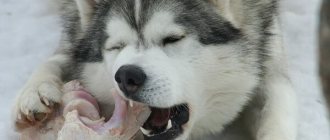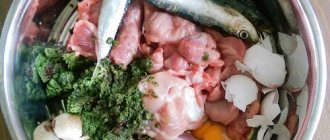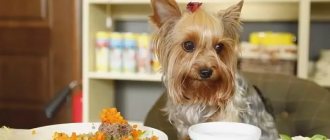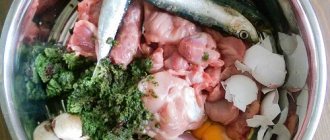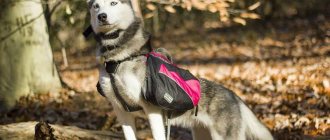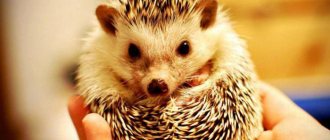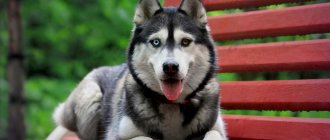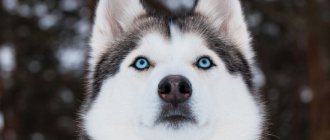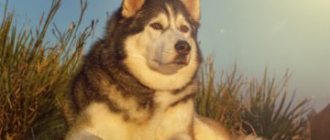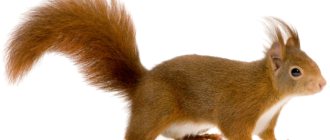Cute blue-eyed dogs, adapted to living in harsh climates, have good health. Mounts were originally intended for northern latitudes. However, Siberian Huskies also do well in families from other regions. In order for a pet to have a long and happy life, the owner needs to take care of it. It is important to devote time not only to care, training and education. You should know what to feed your husky at home - then the dog will be healthy, hardy and cheerful.
Features of a dog's diet: what to feed a Husky?
Husky is one of the oldest breeds. Previously, they were actively used as riding vehicles. Today they have become ordinary companions. This variety is quite large. An adult reaches 28 kilograms. It is distinguished by cleanliness, friendliness, calmness and beautiful appearance. Before getting such an animal, you need to become familiar with its nutritional characteristics. After all, if the diet is prepared incorrectly, there is a high probability that the pet will get sick. This article will tell you what to feed your Husky dog.
Vitamins and supplements in the diet of a husky puppy
During the entire period of active growth, especially at the stage of changing baby teeth, the Husky puppy should receive vitamins and supplements. The following can be added to your puppy's food as natural vitamin supplements:
- High quality meat and bone meal.
- Tricalcium phosphate or other animal feed additives.
- Fish fat.
- Vitamin B complexes are sold in regular pharmacies.
- Omega-3 and Omega-6 - sold in regular pharmacies.
- Brewer's yeast.
- Greens, except onions.
- Sprouted wheat.
- Bran.
Natural vitamin supplements vary in quality and content of substances beneficial to dogs, so they are difficult to dose. As an alternative, you can give your husky puppy commercial vitamin supplements. Veterinarians recommend purchasing several vitamin complexes with a small composition and alternating them.
What food options are there?
You can feed your four-legged friend in different ways. There are 3 main options for creating a diet: using natural products, exclusively dry food, a combination of factory-made food and homemade food. Owners of other breeds often use a mixed type. But in the case of Husky, everything is different. This feeding option is not suitable for this species. Often, feeding a Husky both homemade food and ready-made factory kits leads to the development of serious problems with the digestive tract and negatively affects the animal’s body as a whole. But there are 2 more permitted options. To understand which one is more suitable, you need to familiarize yourself with each one, highlighting the positive and negative aspects.
Natural
Involves cooking at home. It is important not to give food from the table. Huskies cannot be fed just anything. By correctly compiling a list of products, it is quite possible to provide a complete and balanced diet.
P
The advantage of using natural products is:
- No harmful additives. For example, preservatives, flavorings, flavor enhancers, etc.
- Contains natural fiber and natural protein.
- Ability to control food quality. In the case of dry food, this is impossible to do.
However, there are also some disadvantages. So, creating the right menu requires knowledge and time. Not knowing what to feed your Husky, it is better to consult a veterinarian. Cooking also takes a lot of time.
Dry food
Due to the presence of a number of disadvantages of natural food, many dog breeders prefer to use factory-made food kits. But here we need to take into account some points. After all, this food option also has its drawbacks.
If the Husky's diet consists of dry ready-made food, the owner receives the following benefits:
- There is no need to spend a lot of time selecting a menu and preparing food.
- Factory kits contain all the necessary minerals, vitamins and trace elements.
- If you plan to travel somewhere, it is much easier to take dry food with you.
- The shelf life is much longer than that of natural food.
One of the disadvantages is that dry mixtures contain insufficient water. Finding food for a Husky is quite difficult. After all, there is a very large assortment on the shelves of the pet store.
And it is important to be able to correctly find the option that is ideal for your pet. Processed food may contain harmful additives. If the food is of high quality, then its cost will be very high. Husky is a large dog. This means that her need for food is considerable. Therefore, such feeding is not cheap.
When thinking about which food is best for Huskies, dry or wet, it should be said that both options are good. But wet ones are only allowed to be given occasionally, as a treat. But dry granules are quite suitable as a daily diet. You can read about wet dog food here.
Choice
It is up to the pet owner to decide what type of food to choose.
Before deciding on an option, you need to think carefully about everything. If the choice falls on dry food, then it is important to decide on the brand. Only high quality feed should be used. It is better to give preference to foreign manufacturers. Dry food is worth buying super-premium or holistic. It is desirable that the composition contains vitamins and minerals. Otherwise, vitamins for Husky will have to be purchased separately.
It is worth giving preference to those foods that have chicken, lamb, beef or fish in the list of first ingredients. The percentage of protein should be high. Mixtures containing cereal grains are best avoided.
It is important to remember that if dry food for Husky does not contain fish or fish oil, these components should be additionally included in the diet. For example, buy dog canned tuna or mackerel, fish oil supplements.
If the choice fell on natural nutrition, you need to carefully select a list of suitable products. Make sure food is always fresh. Make the right diet. It is useful to buy and give your pet some vitamin and mineral complex.
In many ways, the dog breeder’s decision depends on lifestyle, availability of free time, and level of income. But in any case, Husky must eat properly. You cannot skimp on feeding this breed. After all, subsequent treatment will cost many times more.
Bones as a nutrient
If the dog is fed on the BARF diet, then the basis of the menu is raw bones with meat. In addition to them, the dog receives protein food (dairy products, offal, eggs, fish), dietary fiber and sugar (vegetables and fruits) and fats (oils).
BARF has two meanings: "bones and raw food" or "organic raw food". Thus, the BARF concept is based on feeding the dog only raw food, and individual nutrients must take into account the evolutionary diet. This, in turn, is optimal for the genetic characteristics of each species in nature, and according to the creators of BARF, a dog on this diet can live in health and wellness longer than if it were fed otherwise.
A properly prepared BARF meal should include:
60 percent - raw bones with meat; 15 percent - vegetables; 10 percent - by-products (liver, heart, kidneys, lungs, spleen); 10 percent - eggs, dairy products, butter, cottage cheese, fish; 5 percent - fruits.
BARF Diet ingredients should only come from trusted sources. Meat and offal from young, healthy animals can be frozen in portions and used as needed. It may happen that a dog (especially a very young or old one) becomes constipated after eating bones, then grinding them would be justified.
Bones are not given to dogs that are fed only cooked food and balanced dry food.
What is possible and what is not for Huskies?
It is important to know what you can feed your Husky and what is prohibited.
The animal's body needs proteins, fats and carbohydrates every day. For proper development and growth, the puppy requires polyunsaturated fatty acids. You also need fiber. Calcium is also important.
It is useful to include the following foods in your Husky's diet:
- Meat. This is a source of protein. Normally, it makes up 70% of the total food volume. It is advisable to choose low-fat varieties. For example, turkey, chicken, beef, venison.
- Offal. These include the heart, liver, trachea, spleen and lungs.
- Cartilage. Contains collagen, microelements and vitamins.
- Sea fish. This product is rich in iodine, phosphorus, amino acids, vitamins B, A, D. Contains micro- and macroelements.
- Porridge. It is useful to give rice, buckwheat and oatmeal. They help normalize intestinal function. Their content in the menu is about 10%.
- Low-fat fermented milk products. This is a source of calcium, which is required for the proper development of the musculoskeletal system.
- Vegetables. They saturate the body with minerals and vitamins. It is especially recommended to give cabbage, tomatoes, zucchini, carrots, beans and pumpkin.
- Eggs. Quail or chicken will do.
The following ingredients should not be included in the Husky diet:
- Sugar. It causes dental problems and the development of skin diseases.
- Various seasonings. They have a negative effect on the mucous membranes. Can cause erosion and ulcers.
- Pork and lamb meat. It contains a lot of fat. This is bad for the pancreas.
- Spicy, fried, salted, pickled, smoked food. All this increases the load on the pancreas.
- Bones. They often lead to constipation.
- Milk.
- Sweets.
- Grapes, raisins.
- Potato.
- Nutmeg.
- Products containing flavorings, dyes, artificial preservatives.
- Cold and hot food is also prohibited.
How to feed a Husky?
Deciding on the type of food and creating a menu is not enough. You also need to know how to feed your Husky correctly, at what time, and in what volume. The health status of the pet depends on this.
Husky puppies up to 4 months of age are fed three times a day. Then they switch to two meals a day. A single meal is not recommended, as it can cause intestinal volvulus. The animal should feel good, be active and look healthy. It is not recommended to feed Huskies before walking them. Especially if physical activity is expected.
It is important to give the correct portion sizes.
To do this, use a measuring cup. The amount of food depends on age. Babies need good nutrition as they grow. Young, active dogs need to be kept in shape. Older individuals usually lead a sedentary lifestyle, so they require less food. You can’t underfeed your pet, but you shouldn’t overfeed it either. The animal's weight should be constantly monitored. This is necessary in order not to overfeed the dog, so that the Husky does not become fat, because this deteriorates not only the appearance, but also the health. But we must remember that a pet does not always have to look lean. With little activity, your four-legged friend may get better. This is quite natural and does not indicate errors in nutrition. It is enough to provide the dog with physical activity, and it will regain its former shape.
Features of a dog's diet: what to feed a Husky?
Husky is one of the oldest breeds. Previously, they were actively used as riding vehicles. Today they have become ordinary companions. This variety is quite large. An adult reaches 28 kilograms. It is distinguished by cleanliness, friendliness, calmness and beautiful appearance. Before getting such an animal, you need to become familiar with its nutritional characteristics. After all, if the diet is prepared incorrectly, there is a high probability that the pet will get sick. This article will tell you what to feed your Husky dog.
What food options are there?
You can feed your four-legged friend in different ways.
There are 3 main options for creating a diet: using natural products, exclusively dry food, a combination of factory-made food and homemade food. Owners of other breeds often use a mixed type. But in the case of Husky, everything is different. This feeding option is not suitable for this species. Often, feeding a Husky both homemade food and ready-made factory kits leads to the development of serious problems with the digestive tract and negatively affects the animal’s body as a whole. But there are 2 more permitted options. To understand which one is more suitable, you need to familiarize yourself with each one, highlighting the positive and negative aspects.
Natural
Involves cooking at home. It is important not to give food from the table. Huskies cannot be fed just anything. By correctly compiling a list of products, it is quite possible to provide a complete and balanced diet.
P
The advantage of using natural products is:
- No harmful additives. For example, preservatives, flavorings, flavor enhancers, etc.
- Contains natural fiber and natural protein.
- Ability to control food quality. In the case of dry food, this is impossible to do.
However, there are also some disadvantages. So, creating the right menu requires knowledge and time. Not knowing what to feed your Husky, it is better to consult a veterinarian. Cooking also takes a lot of time.
Dry food
Due to the presence of a number of disadvantages of natural food, many dog breeders prefer to use factory-made food kits. But here we need to take into account some points. After all, this food option also has its drawbacks.
If the Husky's diet consists of dry ready-made food, the owner receives the following benefits:
- There is no need to spend a lot of time selecting a menu and preparing food.
- Factory kits contain all the necessary minerals, vitamins and trace elements.
- If you plan to travel somewhere, it is much easier to take dry food with you.
- The shelf life is much longer than that of natural food.
One of the disadvantages is that dry mixtures contain insufficient water. Finding food for a Husky is quite difficult. After all, there is a very large assortment on the shelves of the pet store.
And it is important to be able to correctly find the option that is ideal for your pet. Processed food may contain harmful additives. If the food is of high quality, then its cost will be very high. Husky is a large dog. This means that her need for food is considerable. Therefore, such feeding is not cheap.
When thinking about which food is best for Huskies, dry or wet, it should be said that both options are good. But wet ones are only allowed to be given occasionally, as a treat. But dry granules are quite suitable as a daily diet. You can read about wet dog food here.
Choice
It is up to the pet owner to decide what type of food to choose.
Before deciding on an option, you need to think carefully about everything. If the choice falls on dry food, then it is important to decide on the brand. Only high quality feed should be used. It is better to give preference to foreign manufacturers. Dry food is worth buying super-premium or holistic. It is desirable that the composition contains vitamins and minerals. Otherwise, vitamins for Husky will have to be purchased separately.
It is worth giving preference to those foods that have chicken, lamb, beef or fish in the list of first ingredients. The percentage of protein should be high. Mixtures containing cereal grains are best avoided.
It is important to remember that if dry food for Husky does not contain fish or fish oil, these components should be additionally included in the diet. For example, buy dog canned tuna or mackerel, fish oil supplements.
If the choice fell on natural nutrition, you need to carefully select a list of suitable products. Make sure food is always fresh. Make the right diet. It is useful to buy and give your pet some vitamin and mineral complex.
In many ways, the dog breeder’s decision depends on lifestyle, availability of free time, and level of income. But in any case, Husky must eat properly. You cannot skimp on feeding this breed. After all, subsequent treatment will cost many times more.
Husky food for health and disease prevention
Your veterinarian may recommend special foods when your dog is sick. Dry food is easy - the clinic will simply give you a recommended list.
Ideally, the veterinary line is the same brand as the main food. If the manufacturer is different, the transition is carried out gradually, mixing feed. The volume of a single serving is reduced, because a sick animal eats less.
When eating natural food, the veterinarian will advise what needs to be added (or excluded) to the food for a specific illness. Do not engage in amateur activities: drinking herbal infusions on your own on the advice of a neighbor is a big risk.
What is possible and what is not for Huskies?
It is important to know what you can feed your Husky and what is prohibited.
The animal's body needs proteins, fats and carbohydrates every day. For proper development and growth, the puppy requires polyunsaturated fatty acids. You also need fiber. Calcium is also important.
It is useful to include the following foods in your Husky's diet:
- Meat. This is a source of protein. Normally, it makes up 70% of the total food volume. It is advisable to choose low-fat varieties. For example, turkey, chicken, beef, venison.
- Offal. These include the heart, liver, trachea, spleen and lungs.
- Cartilage. Contains collagen, microelements and vitamins.
- Sea fish. This product is rich in iodine, phosphorus, amino acids, vitamins B, A, D. Contains micro- and macroelements.
- Porridge. It is useful to give rice, buckwheat and oatmeal. They help normalize intestinal function. Their content in the menu is about 10%.
- Low-fat fermented milk products. This is a source of calcium, which is required for the proper development of the musculoskeletal system.
- Vegetables. They saturate the body with minerals and vitamins. It is especially recommended to give cabbage, tomatoes, zucchini, carrots, beans and pumpkin.
- Eggs. Quail or chicken will do.
The following ingredients should not be included in the Husky diet:
- Sugar. It causes dental problems and the development of skin diseases.
- Various seasonings. They have a negative effect on the mucous membranes. Can cause erosion and ulcers.
- Pork and lamb meat. It contains a lot of fat. This is bad for the pancreas.
- Spicy, fried, salted, pickled, smoked food. All this increases the load on the pancreas.
- Bones. They often lead to constipation.
- Milk.
- Sweets.
- Grapes, raisins.
- Potato.
- Nutmeg.
- Products containing flavorings, dyes, artificial preservatives.
- Cold and hot food is also prohibited.
Problems
Sometimes Huskies may have problems with feeding. This could be due to the food being at an inappropriate temperature or size. It is also possible that the dog is simply tired of a certain food, so the menu should be varied and healthy.
Doesn't eat well
It often happens that a husky becomes capricious and refuses to eat as before due to poor appetite. Often this is a dog’s normal attitude towards food; she eats poorly, but is active and, if there are no signs of illness, then there is no need to worry. The fact is that by their nature, huskies do not tend to eat a lot, and the dog’s poor appetite should not cause you concern.
Refuses to eat
In summer, in hot weather, huskies can abstain from food for 1-2 days on their own. This shouldn't scare you. However, if the dog refuses to eat for more than two days, then it needs to be seen by a veterinarian.
Fat dog
It is very important to ensure that Huskies do not gain excess weight. Dogs of this breed are characterized by a slight degree of thinness, but without signs of exhaustion. Normally, a Husky's spine and ribs should be palpable. If you cannot do this, then the dog is overweight.
Attention! Excess weight can cause problems with the cardiovascular, digestive and musculoskeletal systems in huskies.
How to feed a Husky?
Deciding on the type of food and creating a menu is not enough. You also need to know how to feed your Husky correctly, at what time, and in what volume. The health status of the pet depends on this.
Husky puppies up to 4 months of age are fed three times a day. Then they switch to two meals a day. A single meal is not recommended, as it can cause intestinal volvulus. The animal should feel good, be active and look healthy. It is not recommended to feed Huskies before walking them. Especially if physical activity is expected.
It is important to give the correct portion sizes. To do this, use a measuring cup. The amount of food depends on age. Babies need good nutrition as they grow. Young, active dogs need to be kept in shape. Older individuals usually lead a sedentary lifestyle, so they require less food.
Pasta for dogs: possible or not
I hope that after reading this material, adherents of meat feeding and a raw food diet will not throw rotten tomatoes at us. And at the end of the article, we won’t get a unique Italian pasta with tomato sauce...
After all, today we will talk about whether dogs can have pasta? Should this product be included in the diet, or should it be completely excluded?
We do not make any recommendations. We’ll just try to cover this topic with an open mind and talk about the benefits and harms of pasta for dogs.
Most dogs are food eaters. That is, they eat whatever the owner offers them. However, in order not to harm the health of your furry friend, it is important to properly prepare his nutritious diet. Especially if your dog is straight.
Why does a dog chew bones?
Many owners find that giving their dogs bones is very beneficial. Supposedly this hard product keeps animals' teeth sharp. But in reality, the bones do not sharpen dog teeth at all, but they can damage the enamel, and even tooth breakage is possible. So the bones are completely useless? Bone has several important purposes in a dog's diet:
- Cleaning teeth from plaque.
An animal, gnawing a large femur, removes food particles stuck between the teeth and cleans off accumulated plaque, which is based on bacteria. But it is worth noting that it is not so much the bare bones themselves that clean the teeth, but the cartilage that frames the ends of the bones; - Gum massage.
Moderately hard bones and cartilage (necessarily after heat treatment - at least soaked in boiling water for 5 minutes), when the dog gnaws them, press on the gums, massaging them and preventing the development of diseases such as periodontal disease and gingivitis. - Additionally, it is important to mention that bones make great natural toys for dogs
. Many dogs can play with a bone for a long time without requiring attention from the owner.
Benefit or harm
Some owners of four-legged dogs feed their dogs pasta throughout their lives and claim that everything is fine with their pets. This is probably true. Just like humans, dogs' bodies are completely different. Some can eat cones, noodles or spaghetti without any harm. But other watchdogs may experience negative consequences from eating pasta.
Well now let's look at all the pros and cons.
Let's start with the fact that the main products from which pasta is made are water, flour and eggs. It seems that these components cannot pose anything dangerous to the health of the tailed pet.
Then what's wrong with feeding dogs pasta? Why are they not banned, but at the same time not recommended for feeding?
The fact is that pasta is usually made from wheat flour. And in many animals, wheat causes an allergic reaction. This is perhaps the only danger of this product.
Therefore, if we consider the introduction of pasta into the four-legged diet from this point of view, then we can say that it is possible to give pasta to a dog.
However, there is absolutely no benefit from feeding your dog pasta. Pasta is 70% carbohydrates. And as we know, a dog’s daily menu should contain a minimum amount of carbohydrate food. A dog is a predator. The main product in a predator's diet should be animal protein (meat, poultry, fish). Carbohydrates in large quantities are not only not absorbed by the body and pass through in transit. The most important thing is that they do not carry any nutritional value for the animal’s body.
The only goal that can be pursued when offering pasta to a dog is to instantly satisfy hunger and “fill” the stomach. It is for this reason that pasta is often the main product for feeding animals kept in shelters.
Regular feeding of pasta can lead to pancreatic diseases, pancreatitis, and diabetes in dogs.
The risk of developing obesity increases. Digestive tract upset, gas formation, and bloating may occur. All these problems can arise due to the fact that the four-legged body is not able to digest carbohydrates in such quantities.
Structure and composition of bones
From an anatomical point of view, bone is a multi-tissue organ, consisting mainly of bone tissue, and besides it, many others: adipose tissue, cartilage, hematopoiesis, etc. Each bone is covered with periosteum - a highly innervated fibrous membrane, the task of which is to protect the bone outside. Inside the joints, the bones are covered with articular cartilage. The trunk of the long and flat bones consists of a compact body, while the base of the long bones and the interior of the flat and other bones consists of spongy substance.
The compact body is a calcareous substance high in calcium phosphate, which makes bones hard, stiff and resistant to fracture. On the other hand, the spongy essence has a loose structure consisting of bony trabeculae, occupying from 15 to 25 percent of its volume. The rest is taken up by the bone marrow.
According to their structure and functions, bones are divided into:
Tubular - in the form of short or long tubes, consisting of dense and spongy substance and filled with bone marrow, which mainly performs a hematopoietic function, and the bones themselves have a supporting and protective function (tubular bones of the limbs). Can dogs have tubular bones? No, they are dangerous for a domestic dog (large, medium and small breeds), as the sharp ends can injure the walls of the stomach.
Spongy bones are covered with a compact body; they serve to attach muscles and perform a hematopoietic function.
The bones formed by ossification of tendons (patella) function as cancellous bones.
Flat bones consist of a compact substance. They have a hematopoietic and protective function (scapula, ilium).
Mostly, the bones are inorganic (50-70 percent). As a rule, these are calcium and magnesium salts - chlorides and phosphates. Therefore, it is not a valuable nutrient. Only bone marrow contains fats, proteins, carbohydrates and iron, but not in sufficient quantities to properly nourish a dog.
What kind of pasta and how often can you give your dog?
But, if you decide to include this product in your little tail’s menu, you should know how to properly offer it to your dog:
- Try not to give your dog pasta too often. Once or twice a week is the maximum number of times.
- Offer pasta along with protein foods of animal origin (meat, poultry).
- Do not give your dog dry pasta or instant noodles. In the stomach, the noodles will swell and turn into a paste. Constipation may occur.
- Under no circumstances should you offer your pet pasta with salt, sauces or other spices.
- Do not cook the pasta until it becomes porridge. Let them be a little al dente (al dente - when they are completely cooked, but retain some firmness).
- Buy pasta made from durum wheat. They have less carbohydrates and more fiber.
Well, in conclusion I would like to say. Whether to feed a dog pasta or not is an individual decision for each four-legged owner. Pasta for dogs is neither harmful nor beneficial and is not the main product when feeding natural dogs.
What to feed your husky?
The Husky breed is a small dog.
These animals are rarely obese and are not fanatical about food. Therefore, sometimes it can be quite difficult to feed them, and, in general, to choose a suitable diet for them. But, still, there are exceptions when huskies simply love to eat. Such an addiction can be fraught with problems both for the owner and for the dog himself. Due to their physiological characteristics, these creatures digest meat that is too fatty and oversaturated with protein without problems or unnecessary stress. It is generally accepted that, unlike other colors, huskies have a protein-fat metabolism, and not a protein-carbohydrate one. But this does not mean that you can feed anything. First you need to decide and choose the type of diet. It is divided into:
Both one and the second type have their advantages and disadvantages. For example, dry feeding is a more convenient and practical option for too busy people who simply physically do not have the opportunity and time to prepare culinary masterpieces for their pets and think through the daily diet.
But there is also a negative side - high cost. After all, it is best to give preference to expensive and high-quality goods. They contain more natural ingredients, and therefore more useful substances.
Natural food is an excellent solution when you have time and, most importantly, the desire to cook. After all, you will have to refine yourself every day. Food should always be fresh, sufficiently varied and include various combinations of products.
It is important not to feed your pet from the common table, that is, not to give what you eat yourself. Salt, pepper, and other spices and flavorings can have a negative impact on your dog's digestive system.
What can a husky eat?
If you decide to stop feeding with natural food, then this question is quite relevant for you. The main rule in natural feeding is variety. Under no circumstances should you feed them with cereal or meat alone. The dog should get the maximum amount of useful substances and elements from food.
So, the main diet should be:
- Meat and offal. This is the main type of food that should make up the dog’s daily diet and be supplemented with other healthy foods. In principle, you can give any lean meat. Poultry, rabbit, and veal are perfect. But as for whether Huskies can eat pork and lamb , there is still debate. Some argue that this type of meat is too heavy for this breed and can cause digestive disorders. Others, on the contrary, are in favor with both hands, especially when it comes to lamb. But we are of the first opinion that it is best to exclude or at least minimize these products.
By the way, another fairly common question is: can huskies eat raw meat ? Even though huskies are good hunters, feeding them raw meat should be avoided. If you still decide to pamper your pet with game, it is better to first freeze it or pour boiling water over it. This trick will help rid the meat of harmful microbes and bacteria that can easily enter the pet’s body. Of course, in their natural environment, huskies eat raw meat . But these animals are not dewormed! We are talking about pets who share our shelter, so they must receive all types of sanitary treatment.
- Fish. Many people often wonder, can huskies fish ? If you know how to clean it and are able to sort it out efficiently so that no bones get into the dish, then you’re welcome. Huskies should be given fish at least twice a week. Give preference to marine species, as they have a high content of useful elements and fewer small bones.
- Cereals. Another important component that must be systematically present in the animal’s diet. Husky can eat any cereal: oatmeal, buckwheat, rice, wheat, barley porridge. The exception is pearl barley and millet for huskies. They are too heavy for the stomach and are too difficult to digest. For huskies, porridge is cooked in the usual way; you can use meat or fish broth.
- Vegetables. Vegetables can be eaten in any form, be it raw or boiled. Give preference to carrots, zucchini, onions, beets and cabbage. Add the latter to dishes only if there are no problems with the digestive system and a negative reaction from the body.
- Dairy products. During the feeding period and as they grow older, puppies are given additional milk. But, as soon as the puppy begins to eat on its own, it is better to switch the baby to fermented milk products. The body of an adult husky does not digest milk well. Various allergic reactions and other negative manifestations may also develop. It is better to replace milk with low-fat kefir, natural yogurt, and cottage cheese. Include them in your pet’s menu twice a week and there will be no health problems.
- Fruits. This type of product should not form the main menu. fruits can be given to huskies as a treat . Offer your pet a piece of apple, pear, or banana. Huskies may like cranberry, orange or grape. If there is no negative reaction from the digestive system after eating fruit, you can safely treat it. But in small quantities.
- Husky eggs should also be given once a week. It is best if they are raw, without prior heat treatment. Therefore, to the question, can a husky have eggs , the answer is unequivocal - yes, but no more than one or two eggs per week.
Important! If we are talking about what you can feed a nursing husky , then the diet of such a dog should be as balanced as possible and rich in nutrients. Give milk porridge, include special vitamins in the diet, and it would also be a good idea to give fish oil to husks . This is literally a storehouse of useful substances and elements, which, alas, are washed out of the body “at the speed of light” during lactation.
Diet
When determining the diet for representatives of this breed, it is necessary to focus on products containing proteins, fats, fiber, which is necessary for the normal functioning of the intestines, amino acids, as well as all the necessary vitamins, macro- and microelements.
Diet of an adult husky dog
The animal should eat 2 times a day. Meat component - at least 50%.
Diet option for the day:
- Meat, meat waste (trimmings) - 400 g.
- Fish - 400 g.
- Vegetables - 200 g.
- Cereals - 500 g.
- Vegetable oil - 50 g.
- Salt - 20 g.
Diet for a husky puppy from 1 month
The number of feedings of the pet per day is reduced from 5–6 (when the puppy is 1 month old) to 2 times (when the puppy is 8–9 months old).
Approximate daily diet:
- Meat (offal) - 200 g.
- Fish - 250 g (infrequently).
- Milk - 600 g.
- Boiled carrots - 50 g.
- Cottage cheese or yogurt - 100 g.
- Salt - 5 g.
Diet of a nursing husky
- Offal only - 600–700 g.
- Rice, buckwheat, oatmeal porridge with milk - 500 g.
- Omelette - 200 g.
- Fermented milk products (kefir, cottage cheese) - 200 g.
- Boiled vegetables, greens - 50 g.
What can't a husky do?
We've already figured out what you can give your dog. It's time to talk about foods that should be prohibited, and even their taste should be unknown to your dog. So:
- Floury. For a husky's body, bread, loaf, buns and other baked goods have absolutely no benefit. Therefore, there is no point in including them in the diet. In addition, this product group can negatively affect the digestive system of dogs and provoke the development of obesity.
- Sweets. Dogs, sometimes like little children, will happily gobble up any random candy or chocolate bar. But the trouble is that chocolate is extremely harmful for huskies. It increases blood sugar levels, provokes problems with the gastrointestinal tract and, again, if consumed systematically will lead to excess weight.
- Bones. Haskam chicken bones are prohibited . When broken, they form sharp angles that can easily pierce the walls of the stomach or intestines. Therefore, the answer to the question whether a Husky can have bones is obvious.
- Pasta and potatoes. Many people are interested in whether can have pasta and potatoes ? The answer is approximately the same as with all of the above products. Pasta and potatoes have a low percentage of usefulness and can cause more harm than have a positive effect. In fact, these products are dummies that do not bring anything useful, but only clog the stomach. Therefore, there will be no point and, most importantly, benefit from such feeding.
- Fried and spicy. No matter how pitiful and unhappy the dog looks at you and your fried steak, do not share under any circumstances. Fried, salty, hot and spiced foods have a very detrimental effect on your pet’s body. Of course, we are not saying that a dog’s diet should be completely tasteless and similar to the menu of someone suffering from an ulcer, but overly sophisticated dishes will not bring any benefit.
- Can I have husky cheese? But sometimes you can pamper your pet with cheese. It’s just important to understand that this will only be a treat, and not the main meal. You can cut it into small cubes and take it for a walk to reward your pet for following commands or obedience. But it’s definitely not worth feeding such a product fully.
Overall, you should use common sense and rationality when feeding your dog. You should not rush from one extreme to another, feed your dog from the common table or pamper it with sweets and baked goods. But you also don’t need to be too strict about your dog’s diet. It is important to understand and approach the feeding process according to your dog's needs. After all, something that tastes good and benefits one may cause digestive problems in other pets.
Feeding dry food
It is very important to choose the right dry food. In this case, it is necessary first of all to take into account its composition. Most likely, through testing you will have to select the food that is suitable for a particular dog.
The composition of dry food should be as follows:
- Meat should come first.
- It must be indicated what kind of meat is contained in the food. Foods made from lamb, chicken, and beef are suitable for huskies.
- There are also fish feeds, in which case the type of fish that was used must be indicated. Such food is also suitable for huskies; they can be alternated with meat.
- Vitamin E must be present. In high-quality feed, it is used as a natural preservative.
- The feed should contain a large amount of proteins.
- The composition should not contain grains in the first place. This indicates that the food has low nutritional value and mostly consists of filler, which does not provide any benefit, but only clogs the stomach and intestines, thereby impairing digestion.
- There should also be no artificial colors, flavors or preservatives.
premium and super-premium food meets these requirements , including Orijen, Acana, Canidae, Royal Canine and others. Economy-class dry food cannot be used to feed a husky, just like any other dog, since they contain a large number of harmful additives, are mostly made on the basis of filler, which has a detrimental effect on the digestive system, and do not contain natural meat, but waste slaughterhouses, such as horns and hooves.
Interesting: Staffordshire Bull Terrier
